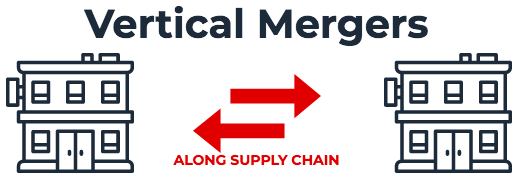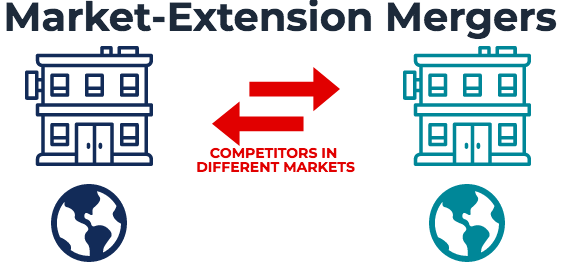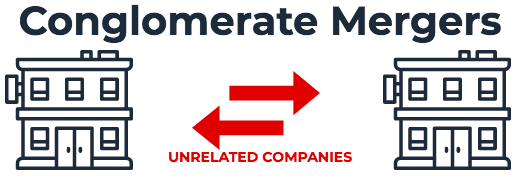several office supply companies decide to combine into one large company. what is this called
What is a Merger?
A merger refers to an understanding in which two companies bring together together to course one company. In other words, a merger is the combination of two companies into a single legal entity. In this article, we volition wait at different types of mergers that companies can undergo.

Types of Mergers
There are five basic categories or types of mergers:
- Horizontal merger: A merger between companies that are in straight competition with each other in terms of product lines and markets
- Vertical merger: A merger betweencompanies that are along the same supply concatenation (e.g., a retail company in the motorcar parts industry merges with a company that supplies raw materials for auto parts.)
- Market-extension merger: A merger between companies in unlike markets that sell like products or services
- Product-extension merger: A merger betwixt companies in the same markets that sell different but related products or services
- Conglomerate merger: A merger between companies in unrelated business activities (eastward.thou., a clothing visitor buys a software company)
Learn nigh modeling unlike types of mergers in CFI's Thousand&A Financial Modeling Grade.
Horizontal Mergers
A horizontal merger is a merger between companies that straight compete with each other. Horizontal mergers are washed to increase market place power (market share), further apply economies of calibration , and exploit merger synergies.
A famous case of a horizontal merger was that betwixt HP (Hewlett-Packard) and Compaq in 2011. The successful merger between these two companies created a global technology leader valued at over US$87 billion.

Vertical Mergers
A vertical merger is a merger betwixt companies that operate along the same supply chain. A vertical merger is the combination of companies forth the production and distribution process of a business. The rationale behind a vertical merger includes college quality control, better flow of information forth the supply concatenation, and merger synergies.
A notable vertical merger happened between America Online and Time Warner in 2000. The merger was considered a vertical merger due to each visitor's dissimilar operations in the supply concatenation – Fourth dimension Warner supplied data through CNN and Time Magazine while AOL distributed information through the internet.

Market-Extension Mergers
A market-extension merger is a merger betwixt companies that sell the same products or services but that operate in unlike markets. The goal of a market-extension merger is to proceeds access to a larger market place and thus a bigger customer/customer base.
For case, RBC Centura's merger with Eagle Bancshares Inc. in 2002 was a market-extension merger that helped RBC with its growing operations in the North American market place. Eagle Bancshares owned Tucker Federal Bank, one of the biggest banks in Atlanta, with over 250 workers and $1.1 billion in assets.

Larn about modeling different types of mergers in CFI'due south 1000&A Financial Modeling Form.
Product-Extension Mergers
A product-extension merger is a merger betwixt companies that sell related products or services and that operate in the aforementioned market. By employing a product-extension merger, the merged company is able to grouping their products together and gain access to more consumers. Information technology is important to notation that the products and services of both companies are non the same, only they are related. The key is that they utilise similar distribution channels and common, or related, production processions or supply chains.
For example, the merger between Mobilink Telecom Inc. and Broadcom is a production-extension merger. The two companies both operate in the electronics manufacture and the resulting merger immune the companies to combine technologies. The merger enabled the combination of Mobilink's 2G and 2.5G technologies with Broadcom's 802.11, Bluetooth, and DSP products. Therefore, the two companies are able to sell products that complement each other.

Learn almost modeling different types of mergers in CFI's M&A Financial Modeling Course.
Conglomerate Mergers
A conglomerate merger is a merger betwixt companies that are totally unrelated. There are two types of a conglomerate merger: pure and mixed.
- A pure conglomerate merger involves companies that are totally unrelated and that operate in distinct markets.
- A mixed conglomerate merger involves companies that are looking to expand product lines or target markets.
The biggest gamble in a conglomerate merger is the immediate shift in business organization operations resulting from the merger, equally the two companies operate in completely different markets and offer unrelated products/services.
For example, the merger betwixt Walt Disney Company and the American Broadcasting Company (ABC) was a conglomerate merger. Walt Disney Company is an entertainment company, while American Broadcasting company is a US commercial circulate television network (media and news company).

More Resources
Thank yous for reading CFI's guide to types of mergers. CFI offers the global Fiscal Modeling & Valuation Analyst (FMVA)™ certification programme for finance professionals. To learn more and expand your career, explore the boosted relevant CFI resources beneath:
- Affiliation
- Consolidation Method
- Mergers and Acquisition Process
- Merger Consequences Analysis
avitiawhissely1974.blogspot.com
Source: https://corporatefinanceinstitute.com/resources/knowledge/deals/types-of-mergers/
0 Response to "several office supply companies decide to combine into one large company. what is this called"
Post a Comment